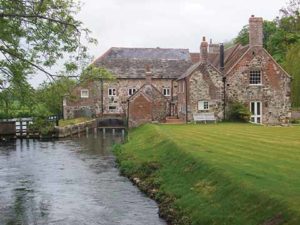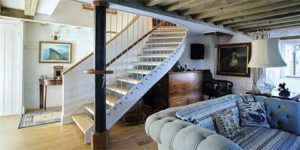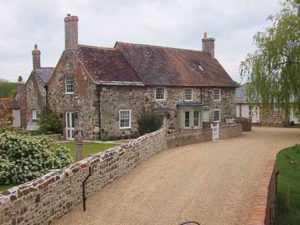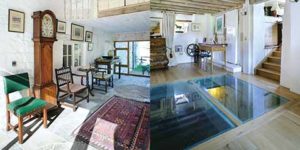Dorset Houses – Bindon Mill
Lucy Peel takes us on a tour of a property that was endowed by Plantagenets and restored by its current owner
Published in August ’18
It is not often that cutting-edge contemporary and historic interiors blend as seamlessly as they do at Bindon Mill, just outside Wool. Part of the Lulworth Estate, the converted mill house on the River Frome dates back many hundreds of years, for this beautiful building is all that remains of a Cistercian monastery, Bindon Abbey.
Founded in 1149 on a site by Bindon Hill, not far from Lulworth Cove, the monastery moved to its new site in 1172. Favoured by a succession of kings, especially Henry III, during its early years, the community benefitted from royal largesse at many points, with gifts such as timber to help with the construction of the new buildings, and it thrived in its new home. However kings are capricious and what they give can just as easily be taken away, and the monastery’s royal patronage did not last. Its withdrawal heralded the start of a decline and, along with internal feuding and economic mismanagement in the 14th century, seriously reduced Bindon Abbey’s wealth and standing.
The community’s fortunes took a further turn for the worse in 1536, when the monastery was scheduled for dissolution, a fate only averted by the Abbot paying £300 to the Crown – a huge amount of money at that time. This expenditure turned out merely to have bought a stay of execution, however, the monastery’s fate had already been sealed and the inevitable eventually happened in 1539, when it was finally suppressed and the community dispersed.
In common with many other religious buildings, the monastery’s site and materials were swiftly re-used, in this case to construct a country house for the new landowner, Thomas Howard, in 1559. Apparently incorporating at least the foundations of the Abbey, this building was similarly destined for destruction, which came about when it was burnt to the ground during the English Civil War.
The mill, however, remained intact – along with the outline of Howard’s gardens, especially the water features – and between 2006 and 2009 the mill’s current occupant, Sally Weld, together with her husband, Wilfrid, converted the building into a very special home. Sadly, Wilfrid died in 2015, but Sally continues to live at the mill and her enthusiasm and delight in the mill remain completely undimmed.
Initially attracted by the outstanding setting, Wilfrid and Sally set about sympathetically restoring the building and garden. The project was not without challenges. The mill was Grade II listed, on a Site of Special Scientific Interest which was also classified as being of special archaeological value, and set within an Area of Outstanding Natural Beauty. As if all those issues weren’t enough, the project was subject to Environmental Agency scrutiny and the remoteness of the site and the riverside setting, features which made it so appealing, created numerous practical problems.
Underlying every aspect of the restoration was a determination to preserve the mill’s architectural features and celebrate its original purpose. To this end, the architects, Morgan Carey, created an astounding glass floor in the ground floor mill room, so that the mill’s fast-flowing leat (water channel) can be seen rushing underfoot. They also retained the grain-sack hoist chute and doors in what is now the front entrance hall. Far from seeming out of place, these details enhance the now-elegant space.
The mill is arranged on two levels with a connecting lift and is now very much a home. The ultra-modern extension with its vast floor-to-ceiling windows and soaring ceiling creates a beautiful living space, in complete contrast to the more intimate interiors of the restored house. The juxtaposition of this light, contemporary space, where the landscape appears to wrap itself around the glass walls, cleverly bringing the outdoors into the room, and the darker, more contained, areas of the original mill is striking. While the extension is bright and outward-looking, the original mill has beams and small, deep-set windows as the main design features. Yet this new addition does not diminish or overshadow the older building
in any way; instead, each benefits from the extreme contrast.
The views over the mill pool and surrounding countryside are quite magnificent and draw visitors out into the garden, which also acts as a gallery. Carefully and sensitively planted to provide colour in all seasons, the stunning garden boasts a shrub garden, hosta beds, wildlife areas and old carp ponds, which sit beside the romantic ruins of the Abbey. An unusual and fascinating feature of the garden is the hydro-electric Archimedes screw, which harnesses the substantial power of the river to produce sustainable energy for the property. An abundance of wildlife, including swans, ducks and kingfishers live peacefully alongside this impressive structure. Even otters have been spotted in this tranquil riverside haven.
As well as being steeped in history, Bindon Mill has strong literary connections. It plays an important role in Hardy’s Tess of the d’Urbervilles as Wellbridge Flour Mills, where Tess’s husband, Angel Clare, was apprenticed as a miller. Clare even dreamt of laying Tess in an open grave next to the Abbey ruins. So if the building itself, its setting, garden and fascinating history are not a sufficient draw, then this is possibly reason enough in itself to visit.
Tours
For one day only this year (26 September 2018) Invitation to View offers the unique opportunity for visitors to be taken around Bindon Mill on a tour led by its owner, Sally Weld.
Lasting between two and two and a half hours, the tour costs £20 and starts with a talk on the history and restoration of the building, after which Sally will take you around the mill and extensive garden. If you book a morning tour you will be treated to a delicious light lunch, while afternoon tours include an indulgent cream tea.
Tours can be booked at
www.invitationtoview.co.uk or via the booking line on 01206-573 948 (the 2019 tour dates are yet to be decided).





